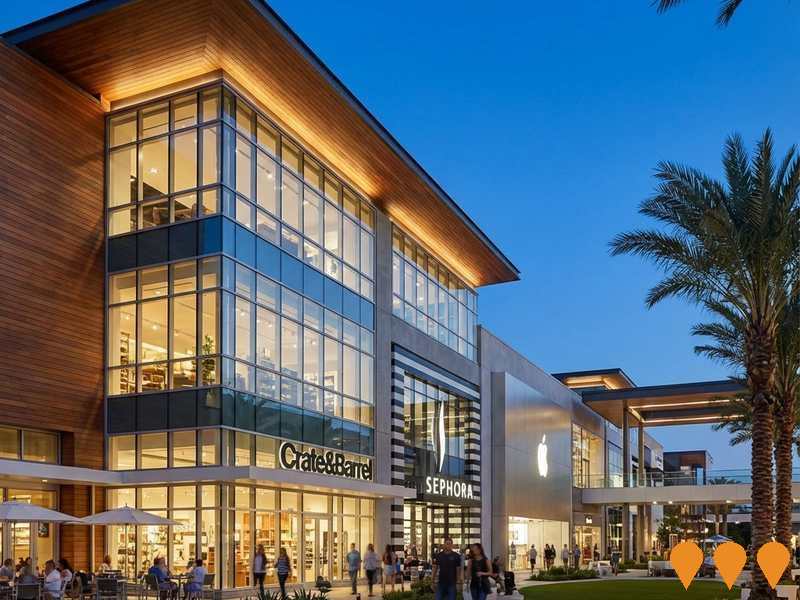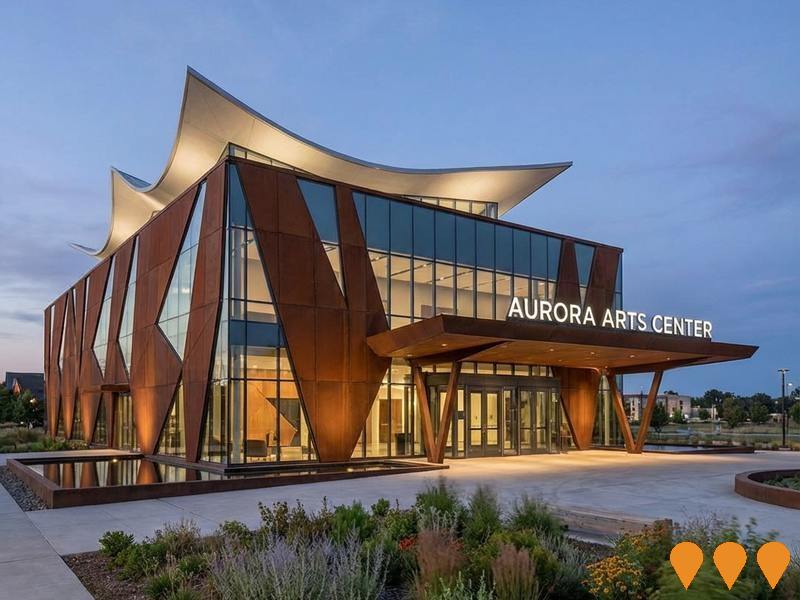Chart Color Schemes
est. as @ -- *
ABS ERP | -- people | --
2021 Census | -- people
Sales Activity
Curious about local property values? Filter the chart to assess the volume and appreciation (including resales) trends and regional comparisons, or scroll to the map below view this information at an individual property level.
Find a Recent Sale
Sales Detail
Population
Horsham Surrounds is positioned among the lower quartile of areas assessed nationally for population growth based on AreaSearch's assessment of recent, and medium term trends
As per AreaSearch's analysis, Horsham Surrounds' population stands at approximately 3,466 as of August 2025. This figure represents a decrease of 5 individuals (0.1%) from the 2021 Census total of 3,471 people. The change is inferred from the estimated resident population of 3,459 in June 2024 and an additional 21 validated new addresses since the Census date. This results in a population density ratio of 0.80 persons per square kilometer. Horsham Surrounds' minimal decline of 0.1% since the 2021 census outperformed the SA3 area's decline of -0.6%. Natural growth contributed approximately 65.9% to overall population gains in recent periods.
AreaSearch employs ABS/Geoscience Australia projections for each SA2 area, released in 2024 with a base year of 2022. For areas not covered by this data, AreaSearch utilises the VIC State Government's Regional/LGA projections from 2023, adjusting using weighted aggregation of population growth from LGA to SA2 levels. Growth rates by age group are applied across all areas for years 2032 to 2041. Based on projected demographic shifts, a population increase just below the median of regional areas nationally is anticipated, with Horsham Surrounds expected to expand by 317 persons to 2041, reflecting an overall increase of 8.9% over the 17-year period.
Frequently Asked Questions - Population
Development
The level of residential development activity in Horsham Surrounds is very low in comparison to the average area assessed nationally by AreaSearch
Horsham Surrounds averaged approximately eight new dwelling approvals per year over the past five financial years, from FY21 to FY25. A total of 42 homes were approved during this period, with one additional approval in FY26 so far. The population has been declining recently, suggesting that new supply has kept pace with demand, providing good options for buyers.
The average expected construction cost value of new properties is $716,000, indicating a focus on the premium market and high-end developments. This financial year, $11.1 million in commercial development approvals have been recorded, suggesting balanced commercial development activity. When compared to the Rest of Vic., Horsham Surrounds shows around 75% of the construction activity per person, placing it among the 31st percentile nationally, implying somewhat limited buyer options while strengthening demand for established dwellings. This level reflects market maturity and possible development constraints.
Recent building activity consists solely of standalone homes, maintaining the area's traditional low density character with a focus on family homes appealing to those seeking space. The estimated population per dwelling approval is 563 people, reflecting its quiet, low activity development environment. Future projections indicate Horsham Surrounds adding 310 residents by 2041. Construction is maintaining a reasonable pace with projected growth, although buyers may encounter growing competition as the population increases.
Frequently Asked Questions - Development
Infrastructure
Horsham Surrounds has moderate levels of nearby infrastructure activity, ranking in the top 50% nationally
Changes to local infrastructure significantly influence an area's performance. AreaSearch identified 21 projects that may impact the area. Notable projects include Horsham Child Care Centre, Horsham South Structure Plan, Avonnefields Regional Development, and Horsham Residential Growth Areas Development. The following list details those likely to be most relevant.
Professional plan users can use the search below to filter and access additional projects.
INFRASTRUCTURE SEARCH
 Denotes AI-based impression for illustrative purposes only, not to be taken as definitive under any circumstances. Please follow links and conduct other investigations from the project's source for actual imagery. Developers and project owners wishing us to use original imagery please Contact Us and we will do so.
Denotes AI-based impression for illustrative purposes only, not to be taken as definitive under any circumstances. Please follow links and conduct other investigations from the project's source for actual imagery. Developers and project owners wishing us to use original imagery please Contact Us and we will do so.
Frequently Asked Questions - Infrastructure
Horsham Hospital Campus Redevelopment Masterplan Implementation (Grampians Health)
Implementation of key priorities identified in the 2018 Redevelopment Masterplan for the Grampians Health Horsham Campus (formerly Wimmera Base Hospital). Priorities include improving Aged Care and In-patient Unit amenity, and increasing the capacity of the Emergency Department (ED) with an opportunity for a fast-track clinic or short-stay area. The project is linked to the Regional Health Infrastructure Fund (RHIF) for capital funding. A master infrastructure plan for the Grampians Health Horsham campus was being developed as of August 2022 to guide future needs and capital investment.
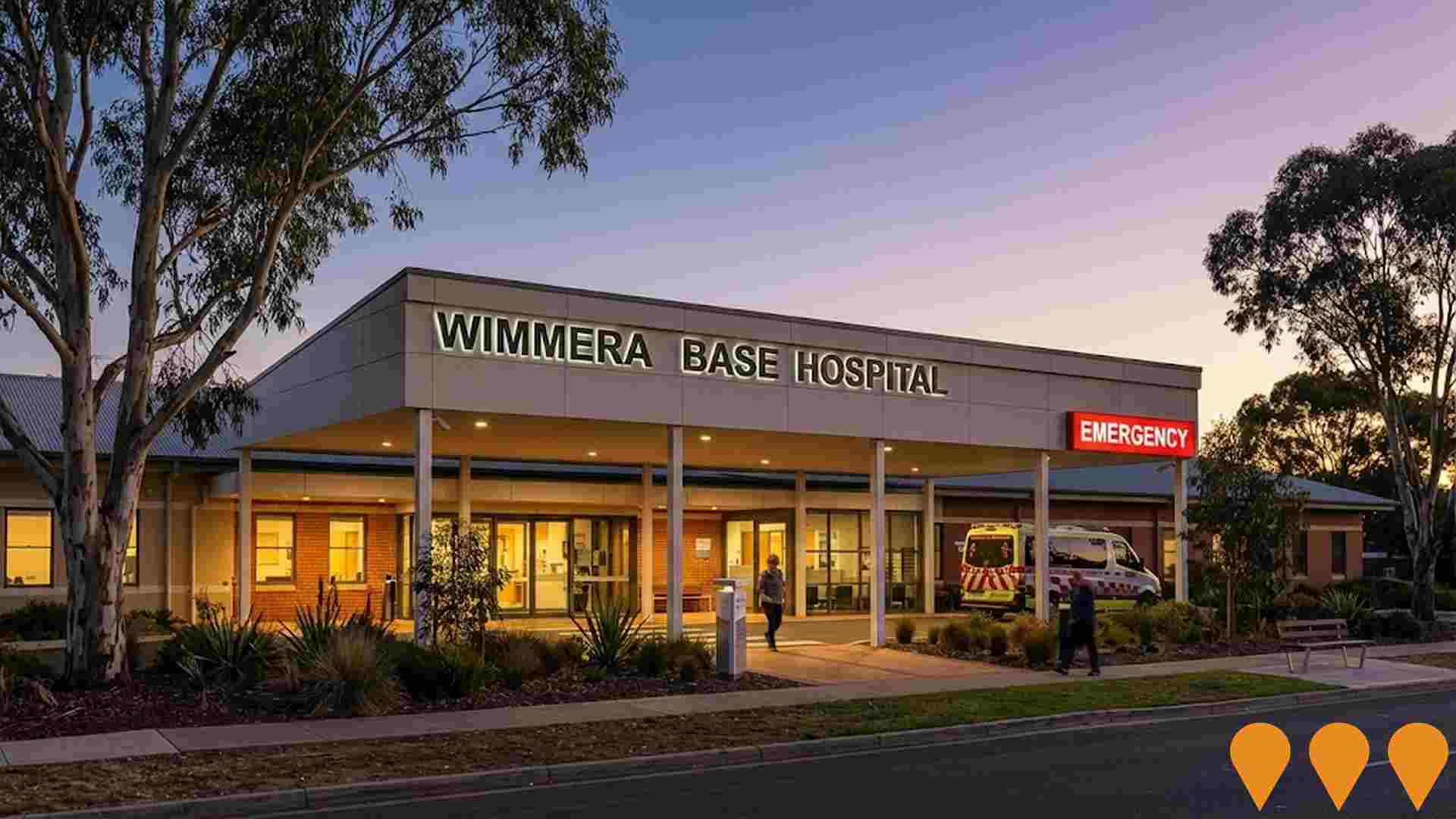
Horsham Residential Growth Areas Development
Strategic residential development across Horsham's designated growth areas, including greenfield development capacity for an estimated 1,021 residential lots. This is part of broader urban planning initiatives to accommodate the Horsham Rural City's projected population growth, with the Council currently developing the 'Horsham and Natimuk Housing Diversity and Affordability Strategy' which is guiding future housing supply and growth areas. The development aligns with the Horsham Planning Scheme.
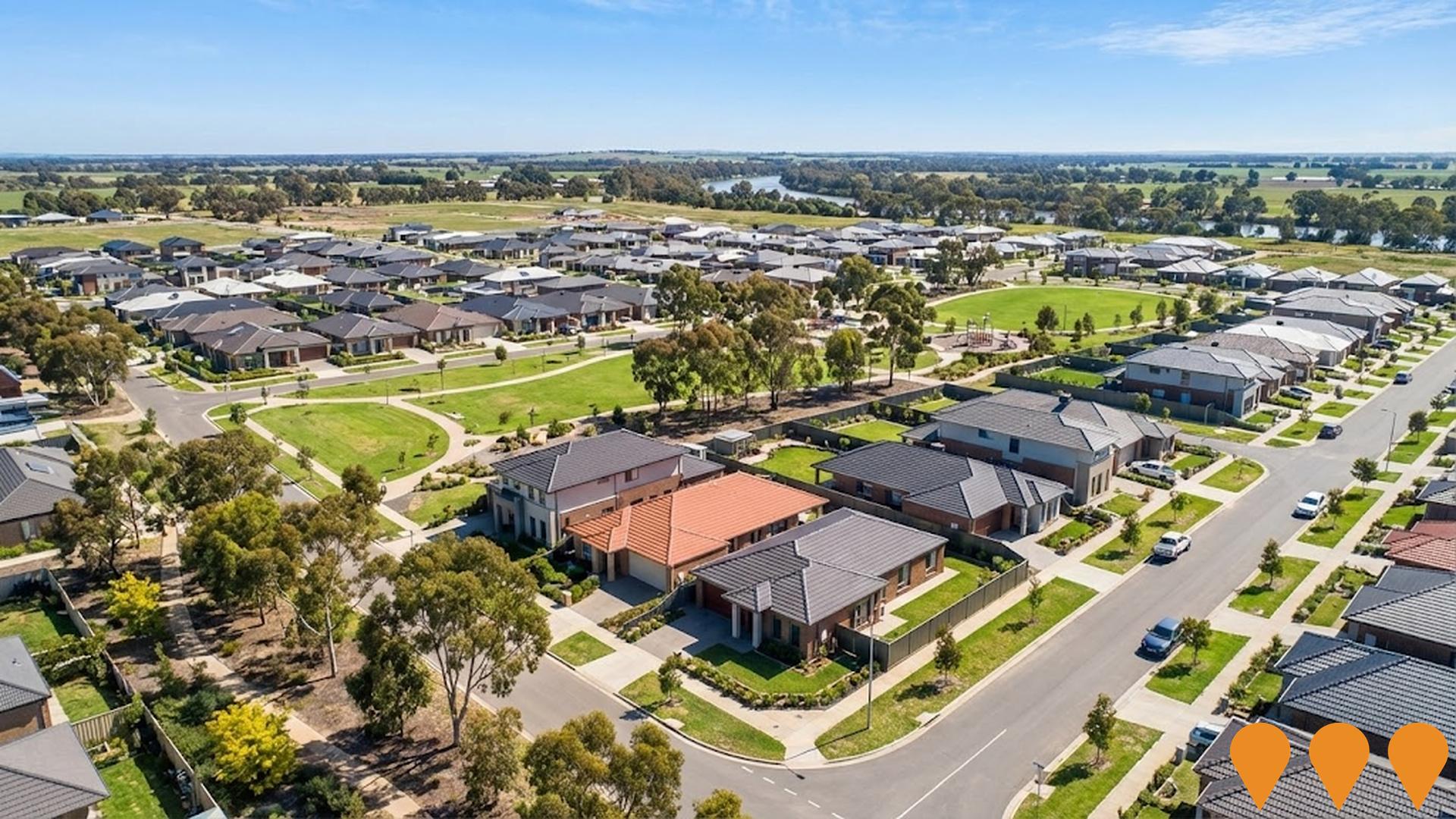
Avonnefields Regional Development
An innovative and genuinely sustainable 50-hectare master planned residential and community development in Horsham, Victoria. Features over 300 dwellings, community hub, aged care precinct, distribution centre, active recreation facilities, flower production precinct, and renewable energy infrastructure including Australia's anticipated largest microgrid. The development includes solar energy generating 25% of electricity from renewable sources, community battery storage, EV charging station, and potential hydrogen production. Current timeline shows rezoning process from September 2024 to March 2025, with construction phases beginning in 2025-2026.

Horsham City Urban Renewal Project
Comprehensive urban renewal project transforming three key precincts in central Horsham to deliver housing diversity and commercial investment. The project focuses on the current council depot site in Selkirk Drive (relocating to Plumpton Road in 2025), the area north of Selkirk Drive and south of Wilson Street, and the area encompassing Firebrace, Madden and Baker streets. Aims to provide 100 new dwellings, 10,000 square meters of apartment space, and 10,000 square meters of office and retail space to address population growth and housing needs.

Horsham SmartWater & Integrated Water Management Project
Innovative recycled water infrastructure project that supports agricultural research and provides drought-proofing for green spaces in Horsham. The completed project delivers 126 megalitres of recycled water annually through a network of pipes connecting to parks, ovals, cemetery, and racecourse, reducing reliance on drinking water for irrigation. Includes Dissolved Air Flotation treatment facility and pipeline infrastructure.

Horsham South Structure Plan
Long-term strategic planning initiative to set out vision for future growth and development in Horsham South area. Currently under consideration with final adoption expected mid-2025 and Planning Scheme Amendment process to follow.
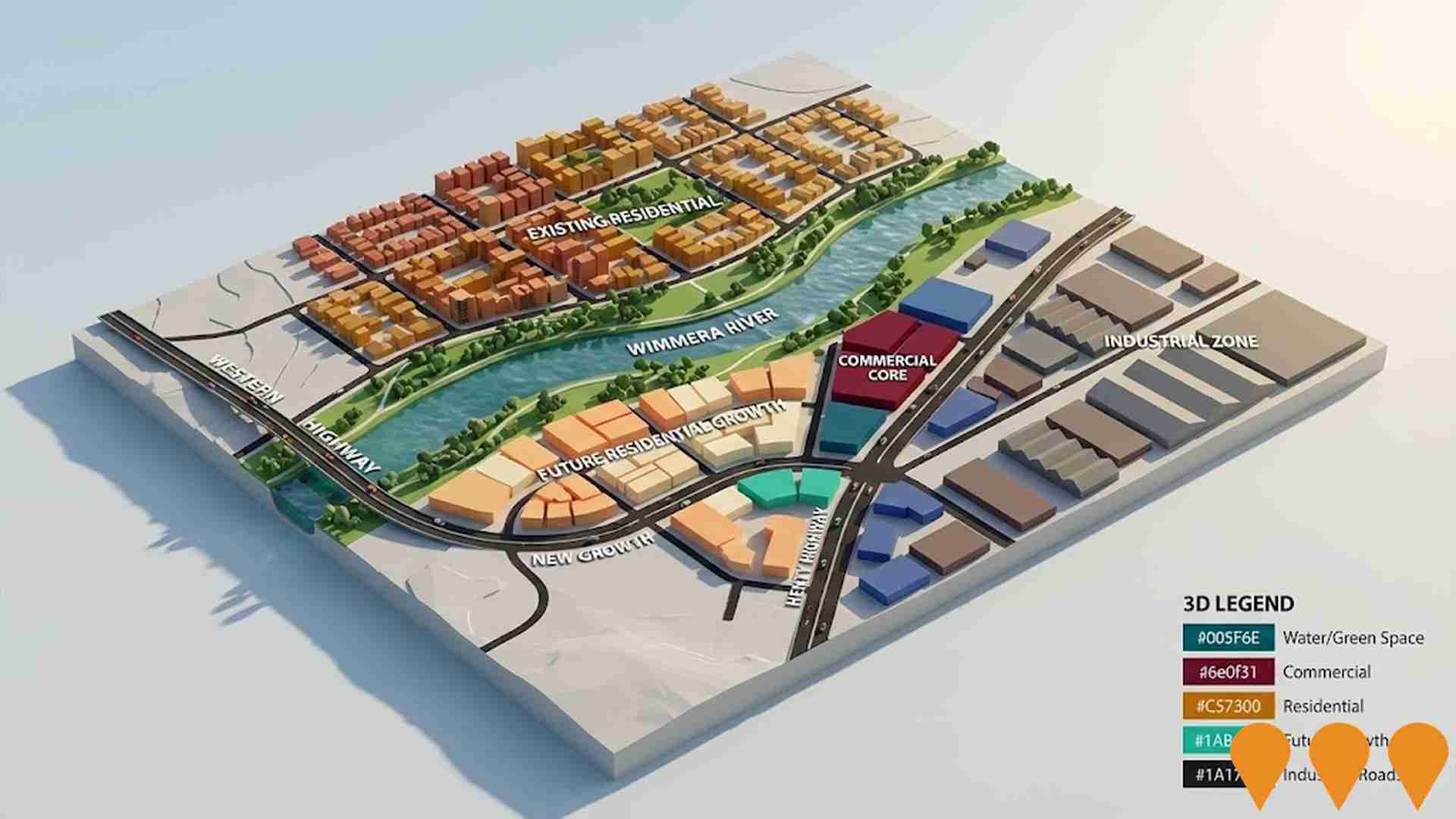
Johnson Asahi Hay Processing Plant
$20 million hay processing facility at Dooen developing new production capacity for export to Japan and Asia. Joint venture between JT Johnson & Sons (established 1923) and Asahi Agria. The facility includes a 5,500m2 processing plant and 550m2 office space, increasing production capacity to process 200,000 metric tonnes annually.

Horsham Child Care Centre
Development approved 102-place single storey child care facility with 613 square metre building, 720 square metre external play area and 23 parking spaces. Located next to Horsham Church of Christ on 1978 square metre site in General Residential Zone.

Employment
Employment conditions in Horsham Surrounds demonstrate exceptional strength compared to most Australian markets
Horsham Surrounds has an employment mix that includes both white and blue collar jobs across various sectors. As of June 2025, the unemployment rate is 1.3%.
In this month, 2,032 residents are employed while the unemployment rate is 2.5% lower than Rest of Vic.'s rate of 3.8%. The workforce participation rate in Horsham Surrounds is 66.9%, compared to Rest of Vic.'s 57.4%. Key industries of employment among residents include agriculture, forestry & fishing, health care & social assistance, and construction. Agriculture, forestry & fishing has a notable concentration with employment levels at 3.8 times the regional average.
Retail trade has limited presence with 5.4% employment compared to 9.9% regionally. Over the 12 months to June 2025, labour force levels decreased by 4.2%, combined with employment decreasing by 4.0%, resulting in a fall of 0.2 percentage points in unemployment rate. In comparison, Rest of Vic. recorded an employment decline of 0.9%, labour force decline of 0.4%, and a rise of 0.4 percentage points in unemployment. Jobs and Skills Australia's national employment forecasts from May 2025 project national employment growth of 6.6% over five years and 13.7% over ten years, with varying rates across industry sectors. Applying these projections to Horsham Surrounds' employment mix suggests local growth of approximately 5.5%% over five years and 12.1% over ten years.
Frequently Asked Questions - Employment
Income
Income levels sit below national averages according to AreaSearch assessment
AreaSearch's latest postcode level ATO data for financial year 2022 shows Horsham Surrounds' median income among taxpayers is $50,505, with an average of $63,239. This is slightly below the national average. Rest of Vic.'s median is $48,741 and average is $60,693. Based on Wage Price Index growth of 12.16% since financial year 2022, current estimates for Horsham Surrounds would be approximately $56,646 (median) and $70,929 (average) as of September 2025. According to the 2021 Census, household, family and personal incomes in Horsham Surrounds rank modestly, between the 39th and 51st percentiles. The income bracket of $1,500 - 2,999 dominates with 34.0% of residents (1,178 people), similar to metropolitan regions where this cohort represents 30.3%. Housing costs are manageable with 93.4% retained, but disposable income is below average at the 50th percentile. The area's SEIFA income ranking places it in the 6th decile.
Frequently Asked Questions - Income
Housing
Horsham Surrounds is characterized by a predominantly suburban housing profile, with above-average rates of outright home ownership
Horsham Surrounds' dwelling structure in its latest Census evaluation showed 98.2% houses and 1.8% other dwellings (including semi-detached, apartments, 'other' dwellings). This compares to Non-Metro Vic.'s 93.0% houses and 6.9% other dwellings. Home ownership in Horsham Surrounds stood at 57.3%, with mortgaged dwellings at 32.9% and rented ones at 9.8%. The median monthly mortgage repayment was $1,134, higher than Non-Metro Vic.'s average of $1,043 but significantly lower than the national average of $1,863. The median weekly rent figure in Horsham Surrounds was $185, lower than both Non-Metro Vic.'s $215 and the national figure of $375.
Frequently Asked Questions - Housing
Household Composition
Horsham Surrounds has a typical household mix, with a higher-than-average median household size
Family households comprise 73.7% of all households, including 31.3% couples with children, 34.0% couples without children, and 7.2% single parent families. Non-family households account for the remaining 26.3%, with lone person households at 24.8% and group households comprising 1.3%. The median household size is 2.5 people, which is larger than the Rest of Vic. average of 2.2.
Frequently Asked Questions - Households
Local Schools & Education
Educational attainment in Horsham Surrounds aligns closely with national averages, showing typical qualification patterns and performance metrics
The area's university qualification rate is 18.7%, significantly lower than Victoria's average of 33.4%. This presents both a challenge and an opportunity for targeted educational initiatives. Bachelor degrees are the most common at 12.3%, followed by graduate diplomas (3.7%) and postgraduate qualifications (2.7%). Vocational credentials are prominent, with 40.5% of residents aged 15+ holding such qualifications - advanced diplomas (12.0%) and certificates (28.5%).
Educational participation is high at 27.3%, including 10.3% in primary education, 9.3% in secondary education, and 2.6% pursuing tertiary education. The Horsham Surrounds area has three schools with a combined enrollment of 23 students, operating under typical Australian school conditions (ICSEA: 1006) with balanced educational opportunities. Education provision is balanced with two primary and one secondary school serving distinct age groups. Local school capacity is limited at 0.7 places per 100 residents compared to the regional average of 13.8, resulting in many families traveling for schooling. Note: where schools show 'n/a' for enrolments, please refer to the parent campus.
Frequently Asked Questions - Education
Schools Detail
Nearby Services & Amenities
Transport
Transport servicing is very low compared to other areas nationally based on assessment of service frequency, route connectivity and accessibility
Transport analysis indicates ten active public transport stops operating within the Horsham Surrounds area as of June 2021. These stops serve a mix of bus routes, with ten individual routes in total providing 125 weekly passenger trips combined. Transport accessibility is rated as limited, with residents typically located 1596 meters away from their nearest transport stop on average.
Service frequency averages 17 trips per day across all routes, equating to approximately 12 weekly trips per individual stop.
Frequently Asked Questions - Transport
Transport Stops Detail
Health
Health performance in Horsham Surrounds is lower than average with common health conditions somewhat prevalent across both younger and older age cohorts
Horsham Surrounds faces significant health challenges with common health conditions prevalent across both younger and older age cohorts. The rate of private health cover is approximately 51% of the total population (~1,774 people), slightly lagging behind the average SA2 area at 48.8%.
The most common medical conditions are arthritis (9.4%) and asthma (8.2%). 67.9% of residents declare themselves completely clear of medical ailments, compared to 61.2% across Rest of Vic.. The area has 20.4% of residents aged 65 and over (708 people), lower than the 25.2% in Rest of Vic.. Health outcomes among seniors are above average, performing better than the general population in health metrics.
Frequently Asked Questions - Health
Cultural Diversity
The latest Census data sees Horsham Surrounds placing among the least culturally diverse areas in the country when compared across a range of language and cultural background related metrics
Horsham Surrounds, as per the census conducted on 27 June 2016, showed low cultural diversity with 92.5% of its population being Australian citizens, 93.9% born in Australia, and 98.1% speaking English only at home. Christianity was the dominant religion, accounting for 52.3% of the population, slightly higher than the regional average of 51.6%. The top three ancestry groups were Australian (33.9%), English (32.8%), and German (8.9%).
Notably, Scottish ancestry was slightly overrepresented at 8.9%, while Serbian was at 0.2% and Dutch at 1.2%, all higher than the regional averages of 9.0%, 0.1%, and 1.1% respectively.
Frequently Asked Questions - Diversity
Age
Horsham Surrounds hosts an older demographic, ranking in the top quartile nationwide
Horsham Surrounds has a median age of 46, which is slightly higher than the Rest of Vic's figure of 43 and significantly higher than the national norm of 38. The 55-64 age group shows strong representation at 16.5%, compared to Rest of Vic.'s figure, whereas the 35-44 cohort is less prevalent at 9.7%. This 55-64 concentration is well above the national average of 11.2%. Post-2021 Census data shows the 25 to 34 age group has grown from 8.8% to 10.7%, while the 15 to 24 cohort increased from 11.8% to 13.2%. Conversely, the 5 to 14 cohort has declined from 12.7% to 10.3%, and the 45 to 54 group dropped from 15.3% to 13.7%. By 2041, Horsham Surrounds is expected to see notable shifts in its age composition. Leading this demographic shift, the 25 to 34 group will grow by 35%, reaching 497 people from 369. Meanwhile, the 75 to 84 and 65 to 74 cohorts are expected to experience population declines.



